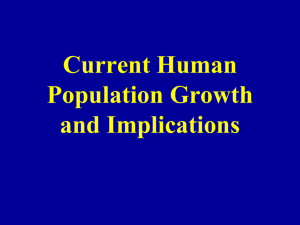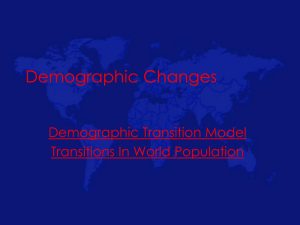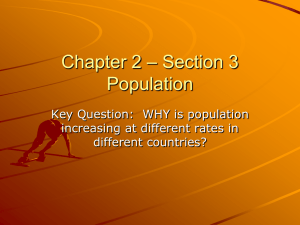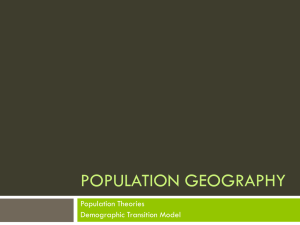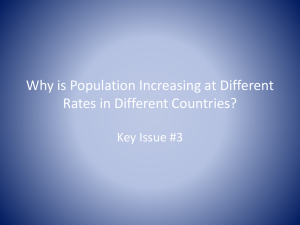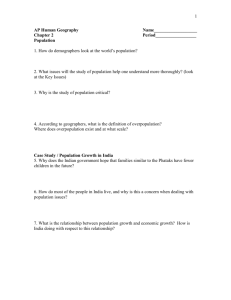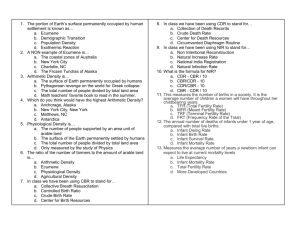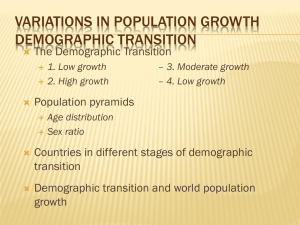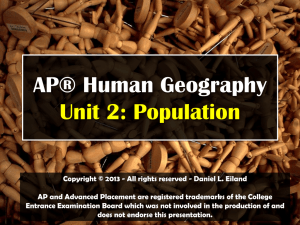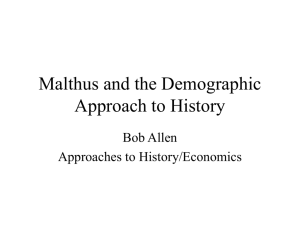Population Issues (Demographics)
advertisement
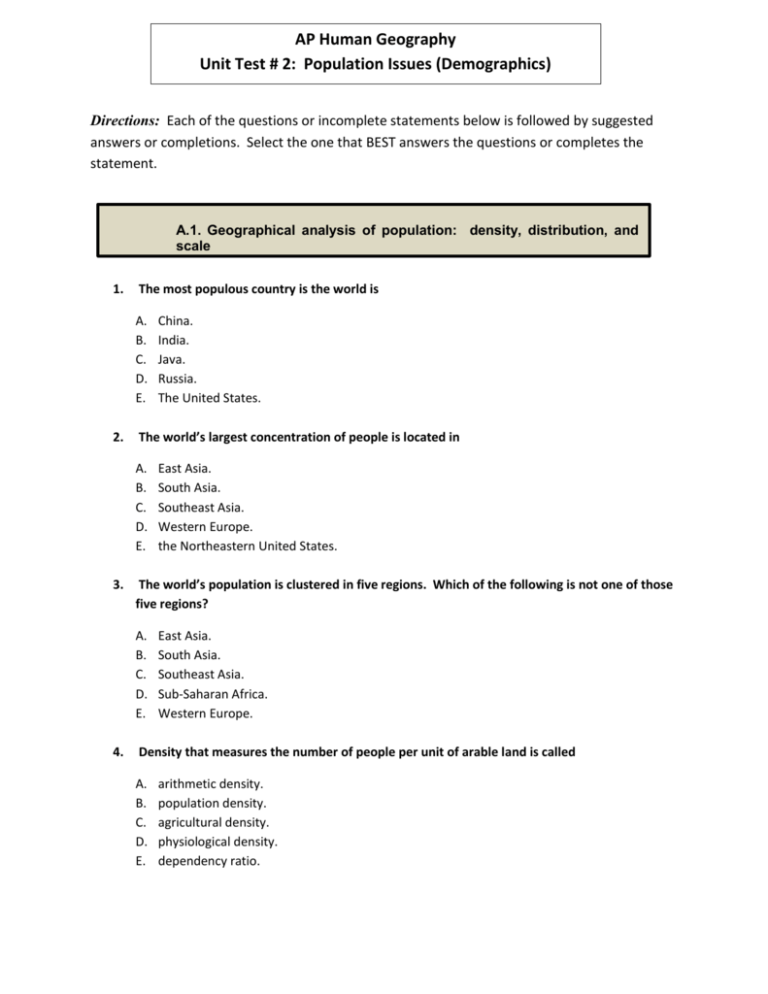
AP Human Geography Unit Test # 2: Population Issues (Demographics) Directions: Each of the questions or incomplete statements below is followed by suggested answers or completions. Select the one that BEST answers the questions or completes the statement. A.1. Geographical analysis of population: density, distribution, and scale 1. The most populous country is the world is A. B. C. D. E. 2. The world’s largest concentration of people is located in A. B. C. D. E. 3. East Asia. South Asia. Southeast Asia. Western Europe. the Northeastern United States. The world’s population is clustered in five regions. Which of the following is not one of those five regions? A. B. C. D. E. 4. China. India. Java. Russia. The United States. East Asia. South Asia. Southeast Asia. Sub-Saharan Africa. Western Europe. Density that measures the number of people per unit of arable land is called A. B. C. D. E. arithmetic density. population density. agricultural density. physiological density. dependency ratio. 5. India and the United Kingdom have approximately the same arithmetic density. From this, we can conclude that the two countries have approximately the same A. B. C. D. E. 6. If the physiological density is much larger than the arithmetic density, then a country has A. B. C. D. E. 7. inefficient farmers. a large number of farmers. a small percentage of the land suitable for agriculture. a large percentage of the land is suitable for agriculture. too many people for the available resources. Most people live in urban areas in which of the following regions? A. B. C. D. E. 8. level of output per farmer. number of people per unit of arable land. number of people per area of land. pressure placed by people on the land to produce food. percentage of land that is suitable for agriculture. East Asia South Asia Southeast Asia Western Europe Great Plains A country with a large amount of arable land and few farmers will have a A. B. C. D. E. high physiological density. low physiological density. high agricultural density. low agricultural density. high population density. A.2. Geographical analysis of population: Consequences of various densities and distributions 9. One important feature of the world’s population with the most significant future implications is that A. B. C. D. E. it is increasing more slowly than in the past. there are more people alive in the world now than at any time in the past. the most rapid growth is occurring in less developed countries. the most rapid growth is occurring in more developed countries. people are uniformly distributed across Earth. 10. Thomas Malthus concluded that A. B. C. D. population increased arithmetically while food production increased geometrically. the world’s rate of population increase was higher than the development of food supplies. moral restraint was producing lower crude birth rates. population growth was outpacing available resources in every country. 11. In comparing Malthus’ theory to actual world food production and population growth during the past half-century, the principal difference is that A. B. C. D. actual food production has been much higher than Malthus had predicted. Malthus’ theory predicted much higher food production than actually occurred. actual population growth has been much higher than Malthus predicted. Malthus’ theory predicted much higher population growth than has actually occurred. 12. Country X has a CBR of 40 and a CDR of 15. Country y has a CBR of 20 and a CDR of 9. Which country has a higher natural increase rate? A. B. C. D. Country X Country Y The rate is the same in both countries. The rate cannot be computed. 13. Consider the following facts about COUNTRY A: The literacy rate is 40% The IMR is 127. Infectious diseases are common within the country. 43% of the population is less than 15 years old. Which of the following statements about COUNTRY A is true? A. B. C. D. E. It is part of a developed region. The country is in stage 4 of demographic transition. COUNTRY A has a high rate of natural increase. It is most likely an LDC. The people who live there have a long life expectancy. 14. The problem with using arithmetic density to investigate the population pattern of a country is that such a density figure does not take into consideration A. B. C. D. annual population increases. internal clustering of people within a country. annexation of a new territory. possible loss of a territory. 15. The population of Earth hovers around 7 billion people. By the year 2050, some demographers project that it will reach 9-12 billion people. Which of these reasons is primarily responsible for the present population and for the soaring growth expected over the next half century or so? A. B. C. D. E. Compulsory schooling provided at government expense is increasingly available to more people and that will continued to be true in the future. Medical care and immunization are extending life expectancy for most of the world’s peoples. There are more people living in cities than in rural areas with continuing urban growth a constant reality. The consistent increase in per capita income indicates a poverty gap. The policies of international organizations such as the United Nations encourage population growth, especially in developing regions. A. 3. Geographical analysis of population: sex, race, and ethnicity Patterns of composition—age, 16. Consider a map that shows the world’s total population. What type of thematic map would best show the size of a country based on its population? A. B. C. D. E. dot isopleth proportional symbol choropleth cartogram 17. Population pyramids measure the breakdown of population by A. B. C. D. E. age and race. age and gender. race and gender. IMR and CBR. CBR and NIR. 18. The population pyramid of Naples, Florida is “upside down” because the city has a large percentage of A. B. C. D. E. elderly people. young people. immigrants. males. females. 19. The population of a country, city, or other region is a function of three variables. Which of the following is not one of those variables? A. B. C. D. births deaths migration ethnic background 20. Of the following statements about life expectancy all are true EXCEPT A. B. C. D. It measures the average number of years someone can expect to live. The average life expectancy for many Sub-Saharan countries is in the mid-30s. People in LDCs tend to have longer life expectancies. The average life expectancy in North America is in the high 70s. A.4. Geographical analysis of population: past, present, and future Population and natural hazards— 21. Which of the following best describes the pandemic of AIDS in Sub-Saharan Africa? A. B. C. D. E. contagious distribution contagious diffusion stimulus diffusion relocation diffusion expansion diffusion 22. How are people identified who are forced to move from their homes to relocation camps in another country because of environmental disasters such as Hurricane Katrina? A. B. C. D. prisoners of war internal migrants migrant workers refugees 23. Geographers define overpopulation as too many people A. B. C. D. E. in a country. in a region. in the world. compared to available resources. compared to schools available to educate young people. 24. Cholera occurs in places with poor sanitation, crowding, war, and famine. In what stage of epidemiological transition are these places? A. B. C. D. E. Stage 1 Stage 2 Stage 3 Stage 4 Stage 5 B. 1. Population growth and decline over time and space: Historical trends and projections for the future 25. The world’s population reached 6 billion people in 1999. Some projectionists argue that it could reach 12 billion people in approximately 45 years. The period of 45 years is known as A. B. C. D. doubling time. life expectancy. natural increase rate. IMR. Population Pyramids of Three Countries A B C 26. Based on the information gained from the population pyramids pictured above, which country is most likely an LDC? A. B. C. D. Country A Country B Country C None of the countries are an LDC. 27. Which of the countries pictured above is experiencing negative growth? A. B. C. D. Country A Country B Country C None of the countries are experiencing negative growth B. 2. Population growth and decline over time and space: fertility, mortality, and health Patterns of 28. The annual population growth rate increased approximately two hundred years ago because of A. B. C. D. E. the First Agricultural Revolution. the Industrial Revolution. demographic transition. epidemiological transition. the medical revolution. 29. The medical revolution has been characterized by A. B. C. D. E. the development of new inventions. diffusion of medical practices. increased agricultural productivity. the invention of new medicines. Both B and D 30. Life expectancy is lowest in A. B. C. D. E. Africa. Europe. Asia. North America. South America. 31. For every 1000 babies born in Mozambique this year, nearly 150 of them will die before they reach their first birthday. The rate of 150 deaths per 1000 births is known as the A. B. C. D. E. CBR. CDR. IMR. CMR. TFR. 32. In terms of epidemiological transition, chronic diseases associated with aging begin to occur in which stage? A. B. C. D. E. Stage 1 Stage 2 Stage 3 Stage 4 Stage 5 B. 3. Population growth and decline over time and space: variations of demographic transitions Regional 33. Which of the following is a characteristic of an LDC? A. B. C. D. E. low literacy rates low rates of natural increase available health care high literacy rates Both A and B 34. Which of the following reasons explains why today’s more developed societies have moved from stage 3 to stage 4 of demographic transition? A. B. C. D. E. Women have entered the work force. There has been diffusion of birth control techniques. Education has improved for women. All of the above are correct. Only A and B are correct. 35. In an analysis of demographic transition, which of these sequences fails to complement the model? A. B. C. D. E. Stage 1: Stage 4: Stage 2: Stage 3: Stage 1: high CBR and high CDR low CBR and low CDR high CDR and low CBR moderate population growth low population growth 36. The annual global population growth rate increased approximately 10,000—12,000 years ago because of the A. B. C. D. First Agricultural Revolution. Medical Revolution. Industrial Revolution. The Gravity Model. 37. Study the figure below showing the Demographic Transition Model. What factor most likely accounts for a country being positioned in Stage 4? A. improved technology and adequate food supply B. significant emigration C. significant immigration D. a mass exodus of rural people to the cities E. war and famine B. 4. Population growth and decline over time and space: Effects of pro- and anti-natalist policies 38. Which country’s population policy has resulted in a disproportionate number of males compared to females who are currently of “marrying age”? A. B. C. D. E. India Japan China Italy Germany C. 1. Population Movement: Major voluntary and involuntary migrations at different scales 39. Which of the following events would be considered a migration pull factor? A. B. C. D. E. communist takeover of a government failed harvest flooding of a town by a river opening of a new factory civil war 40. According to Ravenstein, migrants who move longer distances tend to choose A. B. C. D. E. warmer destinations. open “frontier” areas. big-city destinations. small towns. to migrate as a family unit. 41. If you were trying to determine the gravitational pull of a location, which of the following formulas would you use? A. B. C. D. E. G = Distance/Population G = Population/Distance G = CBR/CDR P = Gravitational Pull/Distance None of the formulas is appropriate. 42. Most Asians are currently migrating to the U.S. through a process known as A. B. C. D. E. brain drain. illegal immigration. chain migration. transferability. periodic movement. C. 2. Population Movement: space Short-term, local movements, and activity 43. A physical feature, such as a large body of water, which hinders migration, is an example of A. B. C. D. E. an environmental push factor. distance decay. an intervening opportunity. an intervening obstacle. an environmental pull factor. 44. Which of the identified types of movement below creates your activity space? A. B. C. D. E. periodic migratory cyclic emigration linear 45. For which of the following reasons do modern Americans usually engage in interregional moves? A. B. C. D. E. marriage job promotions individual personality divorce all of the above

